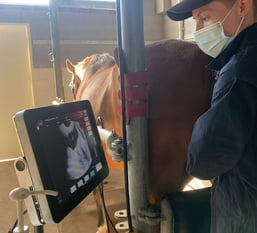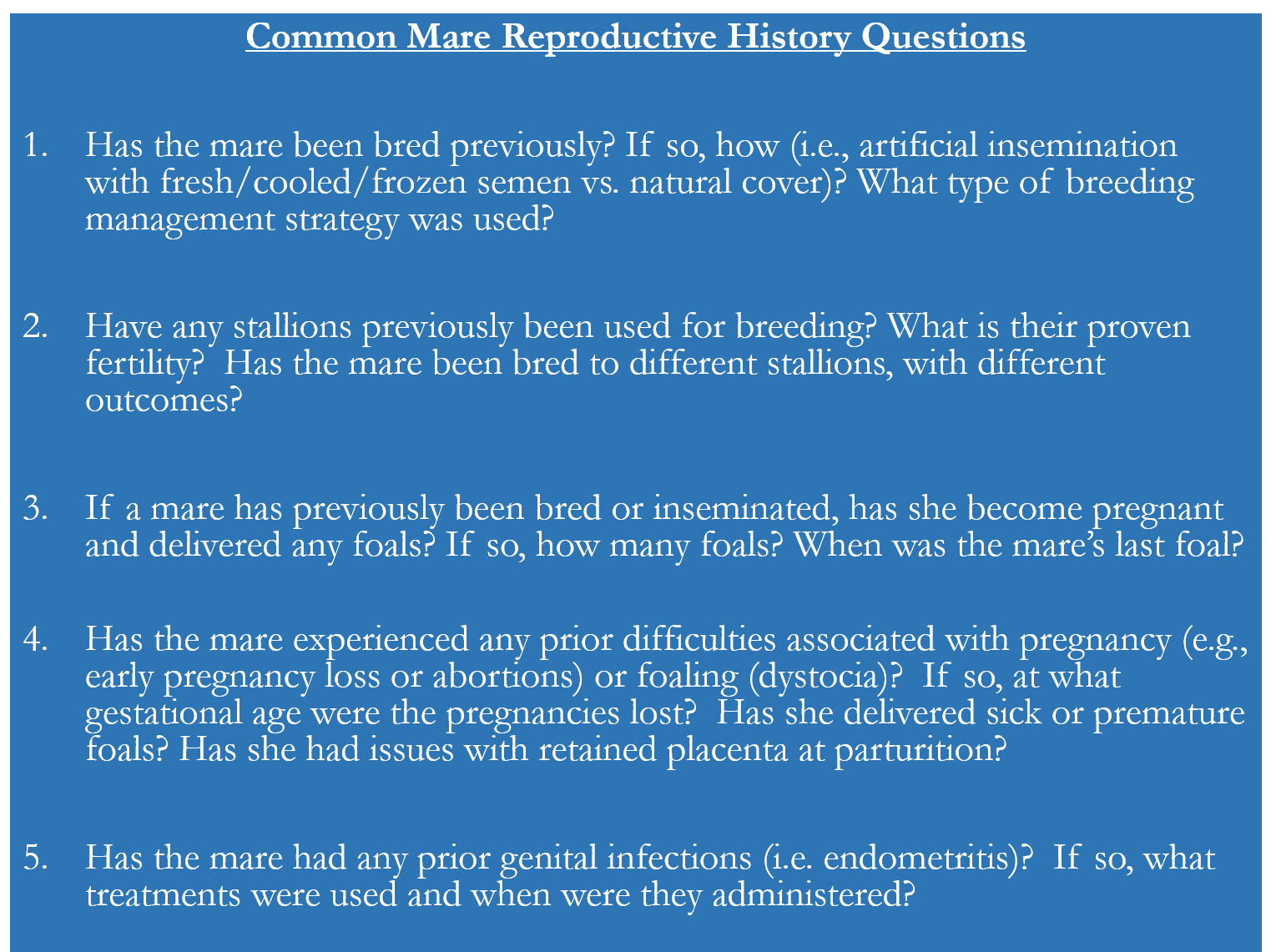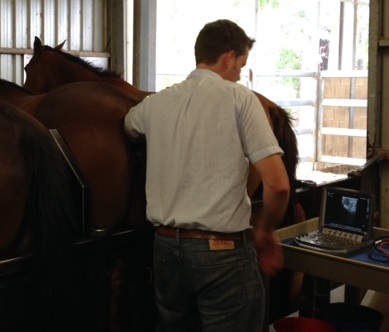 To evaluate a mare's potential for reproductive success or failure, veterinarians often perform a "breeding soundness examination" (BSE). As the breeding season approaches, many owners may opt for a pre-breeding BSE to identify and address any potential reproductive issues prior to breeding. This examination is invaluable for estimating the likelihood of a mare successfully conceiving, carrying a pregnancy to term, and delivering a healthy foal. Pre-breeding examinations are usually performed early in the breeding season when the mare has just begun to cycle or, at the very least, is not in anestrus. Furthermore, the BSE provides veterinarians and owners with important information to determine whether a particular mare should carry a foal herself or whether she might better serve as an embryo or oocyte donor, as well as what breeding strategies are most appropriate for the individual mare.
To evaluate a mare's potential for reproductive success or failure, veterinarians often perform a "breeding soundness examination" (BSE). As the breeding season approaches, many owners may opt for a pre-breeding BSE to identify and address any potential reproductive issues prior to breeding. This examination is invaluable for estimating the likelihood of a mare successfully conceiving, carrying a pregnancy to term, and delivering a healthy foal. Pre-breeding examinations are usually performed early in the breeding season when the mare has just begun to cycle or, at the very least, is not in anestrus. Furthermore, the BSE provides veterinarians and owners with important information to determine whether a particular mare should carry a foal herself or whether she might better serve as an embryo or oocyte donor, as well as what breeding strategies are most appropriate for the individual mare.
In addition to its utility as a pre-breeding assessment, a thorough BSE is also highly recommended for anyone looking to purchase a prospective broodmare. Pre-purchase BSEs provide critical insights concerning the potential value of a mare as a breeding prospect. Finally, BSEs are also indicated for evaluation of “problem” mares with a history of subfertility or unexplained infertility. In all cases, a timely BSE provides essential information for both the owner and veterinarian to optimize breeding management strategy.
This article will review the components of a standard breeding soundness examination and touch upon ancillary diagnostics and treatments that may be pursued to work up sub-fertile mares. The standard BSE includes:
- collection of a thorough and detailed patient history
- general physical examination
- examination of the external reproductive genitalia
- palpation and ultrasonography per rectum
- uterine culture, cytology, biopsy, and/or low volume lavage
- manual/visual vaginal examination.
Patient History
The first step of every BSE is the collection of reproductive history which is crucial to evaluating the current status of the mare (e.g., maiden, foaling, or barren). General patient information includes a mare’s age, breed, general health, previous athletic use, vaccination and deworming history, previous injuries or illnesses, and identification of any medications currently and/or previously administered. More specific information regarding a mare’s reproductive history may include details of the mare’s estrous cycle (such as length and behavior, teasing method, etc.), current stage of the cycle if known, prior or planned breeding dates, previous pregnancy information, and overall uterine health.
More advanced inquiries will generally be pursued for mares with a more extensive subfertility history.

General Physical Exam
While the BSE is focused on reproductive health, the general health of the mare must also always be evaluated. A general physical examination is always performed and can identify problems that may interfere with a mare’s ability to conceive, carry, give birth to, and raise a healthy foal.
Overall body condition is particularly important as it affects how the mare may cycle, as well as her ability to carry a foal to term. Mares entering the breeding season in good body condition and who maintain good body condition tend to have an earlier onset of regular estrous cycles and higher pregnancy rates than mares in poorer body condition or who lost body condition during the breeding season. Ideally, open mares should be lean heading into the breeding season and be gaining body condition. On the other hand, a mare with too high a body condition score may suffer metabolic issues (such as Equine Metabolic Syndrome) and could have associated problems with appropriate cycling and fertility. Another key physical attribute to assess is orthopedic soundness. Although a broodmare does not need to be as sound as a high-end performance horse, lameness can affect overall body condition and her ability to tolerate pregnancy.
External Reproductive Exam
Following a general physical examination, an external reproductive exam of the mare’s external genitalia—including the anus, perineum, vulva, clitoris, and mammary glands—is performed. The hindquarters and tail are assessed for evidence of vulvar discharge or urine staining. Vulvar apposition is key for preventing aspiration of air or manure into the vestibule or vagina. Additionally, a “windsucker” test may also be performed to assess the competency of the vestibulo-vaginal ring—this is important to prevent air from being aspirated into the vagina (causing a pneumovagina). An incompetent vestibulo-vaginal ring may lead to (recurrent) uterine infection. A Caslick’s operation may also be performed in mares with poor perineal conformation (i.e., sunken anus or poor vulvar tone) or in mares with previous issues with placentitis, uterine infection, etc.
Examination of the clitoris should also be performed during this stage of the exam. Enlargement of the clitoris may occur in mares with disorders of sexual development, such as pseudo- or true hermaphroditism. While not routine, it may also be prudent to culture the clitoral fossa in certain cases. The clitoral sinuses can harbor bacteria, which may lead to ascending uterine infection during breeding via artificial insemination or natural cover and may ultimately result in recurrent endometritis.
The mammary glands are also assessed during this part of the examination to ensure the mare has two healthy glands and no apparent signs of mastitis, abscesses, or neoplasia. The glands should be symmetrical with no heat or pain observed on palpation, and the teats should be anatomically normal and consistent with the mare’s foaling status.
Examination of Genital Tract by Palpation and Ultrasonography per rectum
 Following external examination, the mare is appropriately restrained for transrectal palpation of the reproductive tract. First, the cervix is evaluated to assess whether the shape and degree of relaxation correlates with the apparent stage of the estrous cycle and the mare’s foaling status. Next, the uterus is palpated, with particular emphasis on evaluating the mare’s pregnancy status. Pregnancy or lack of pregnancy can later be confirmed via ultrasonography, but a thorough manual palpation is essential prior to the use of the ultrasound. Endometrial folds are palpable in non-pregnant uteri, fluid should not be palpable in a non-pregnant uterus, and the uterus should be assessed for sacculations or masses. Uterine neoplasia or cancer is not common but is important to evaluate.
Following external examination, the mare is appropriately restrained for transrectal palpation of the reproductive tract. First, the cervix is evaluated to assess whether the shape and degree of relaxation correlates with the apparent stage of the estrous cycle and the mare’s foaling status. Next, the uterus is palpated, with particular emphasis on evaluating the mare’s pregnancy status. Pregnancy or lack of pregnancy can later be confirmed via ultrasonography, but a thorough manual palpation is essential prior to the use of the ultrasound. Endometrial folds are palpable in non-pregnant uteri, fluid should not be palpable in a non-pregnant uterus, and the uterus should be assessed for sacculations or masses. Uterine neoplasia or cancer is not common but is important to evaluate.
After both uterine horns and uterine body are palpated, the ovaries should be evaluated for size, presence and size of follicles, and presence of the ovulation fossas. Finally, the pelvis itself should also be palpated to assess diameter and symmetry; any healed pelvic fractures or other abnormalities may increase the likelihood of dystocia.
After the reproductive tract has been palpated, the tract can then be examined via transrectal ultrasonography. Most importantly, the mare should be confirmed to be not pregnant prior to proceeding with the remainder of the BSE , which involves direct vaginal and intrauterine examination. In addition to confirming that the mare is open and not pregnant, the uterus is also examined for the presence of endometrial cysts, intrauterine edema, and/or intrauterine fluid. The ovaries are further examined for the presence and accurate measurement of follicle size as well as the detection of corpora lutea. Para-ovarian cysts and ovulation fossa cysts may also be noted. The cervix should be visualized via ultrasound and examined for abnormalities, and the vagina should also be assessed for the presence of vaginal fluid/exudate or urine. It is also useful to examine the bladder via ultrasonography to evaluate its overall character, as well as the presence of any sediment or calculi.
Uterine and Vaginal Evaluation
Endometrial culture and cytology samples are then collected by a veterinarian. It is important to always interpret culture findings together with uterine cytological findings. Through the same outer guard introduced for uterine culture sample collection, a cytology brush or swab can subsequently be introduced into the uterus to collect cytology samples. The swab or cytology brush can then be gently pressed on a slide, which can be quickly stained and evaluated for the presence of inflammation or infection. The cervix should also be palpated to evaluate competency and the presence of any abnormalities, such as intra-cervical adhesions or cervical tears. The vagina should also be palpated to identify any lacerations or abnormalities.
While the mare’s perineum is still clean and free of manure, a speculum can be introduced to visually evaluate the vagina, cervix, and vestibulo-vaginal ring. The vagina should be assessed for the presence of fluid (e.g., urine, blood, mucus, etc.), lacerations, or other abnormalities, such as varicose veins. As the speculum is removed, the competency of the vestibulo-vaginal ring can also be examined for adequate closure.
Following endometrial culture/cytology and speculum examination, an endometrial biopsy sample is collected for histologic evaluation. This sample is placed in a fixative and then prepared for histologic examination to evaluate the likelihood of a mare’s endometrium to support carrying a foal to term. Pathologies such as endometritis (superficial or extending deeper into the endometrium), peri-glandular fibrosis, cystic glandular distension, and lymphatic distension can be observed and fully assessed, establishing an endometrial “grade” correlating with the likelihood of carrying a foal to term.
Additional Diagnostics
Though not routine, more advanced BSE diagnostics, such as low volume uterine lavage, hysteroscopy, hormonal analysis, karyotype, and/or oocyte evaluation, may be warranted in certain “problem” mares. Hysteroscopy (endoscopic examination of the uterus) is highly useful for visual intrauterine examination—endometrial cysts can be visualized and even removed if deemed a hindrance for pregnancy recognition or maintenance, transluminal adhesions can be observed, foreign bodies (e.g., marbles, broken culture swabs, etc.) can be identified and removed, and potential neoplastic lesions can be identified and biopsied. Hysteroscopy further allows the direct visualization of both oviduct papillae.
 More advanced BSEs may also include hormone level analysis. Evaluation of systemic levels of progesterone, estrogens, testosterone, inhibin, FSH/LH, and anti-Mullerian hormone may be beneficial in certain cases, particularly if a mare is suspected of having an ovarian tumor, such as a granulosa (theca) cell tumor.
More advanced BSEs may also include hormone level analysis. Evaluation of systemic levels of progesterone, estrogens, testosterone, inhibin, FSH/LH, and anti-Mullerian hormone may be beneficial in certain cases, particularly if a mare is suspected of having an ovarian tumor, such as a granulosa (theca) cell tumor.
A new diagnostic tool for evaluation of sub-fertile mares who have otherwise sound reproductive health, extensive breeding management, and insemination with semen from proven fertile stallions, involves examination of the mare’s oocytes (eggs). Through transvaginal follicle aspiration for oocyte recovery—a simple, standing procedure—a mare’s oocytes can be harvested. These oocytes can be sent to a diagnostic lab for intracytoplasmic sperm injection (ICSI) to directly examine the viability of the oocytes and identify potential primary gamete (oocyte) developmental issues. Though this diagnostic modality is relatively new, it is already providing exciting insights for mares with unexplained infertility.
Conclusion
The BSE provides the foundational assessment of a mare’s ability to conceive and carry a foal to term. Diagnostics may identify particular problems and aid the veterinarian and owner in determining the proper treatment and optimal breeding management plan for the mare. It is rare to definitively label a mare as “sterile”, even though particular problems, such as extensive endometritis or poor endometrial biopsy grade, may result in a guarded reproductive prognosis. However, even when all BSE findings are normal and a veterinarian can establish that a mare is a “satisfactory breeding prospect,” fertility is not absolutely guaranteed. The BSE is necessarily limited to the findings at the particular point in time it is performed and cannot guarantee a mare’s future fertility. The ultimate proof of a mare’s reproductive soundness is the successful carrying of a foal to term and the delivery of a healthy foal that stands and nurses at her side. A proper BSE can provide fundamentally critical information for optimally managing and maximizing a mare’s reproductive career.
You may also be interested in the following articles:





